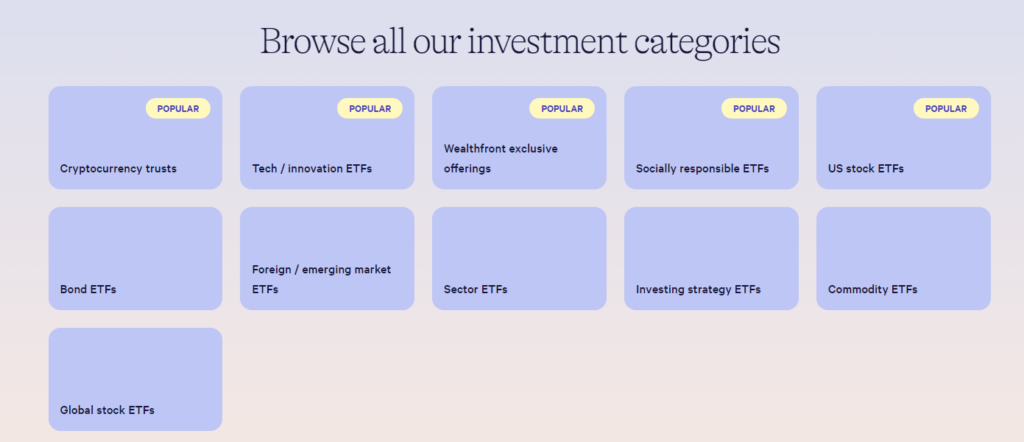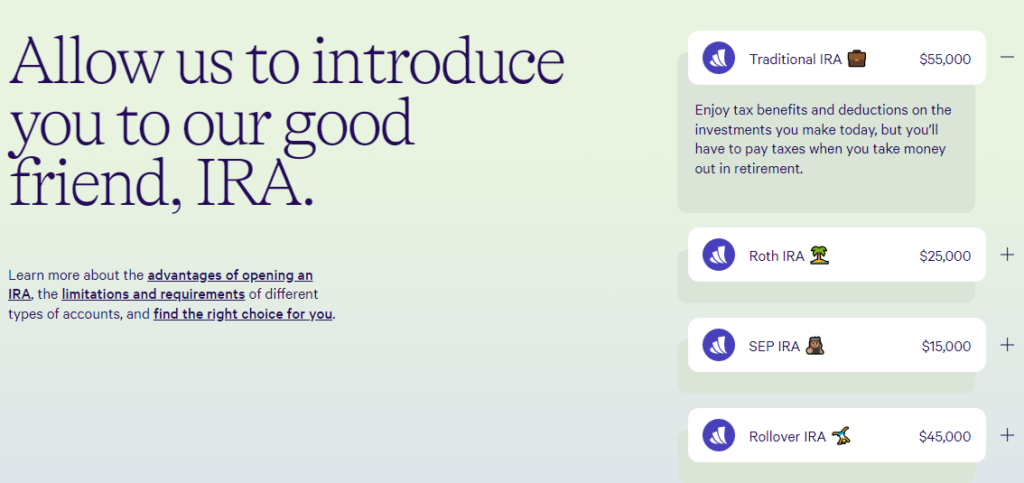
- No maintenance fees for the first $10,000
- Extremely low fees even after reaching $10,000 threshold
- Tax-loss harvesting options for most accounts
- Direct indexing for accounts over $100,000
- Free Portfolio Review Tool
- No discounts for large balances
- No fractional share purchases for your ETF
- No individual customization for ETFs
- No cash equivalent investments
| 💰 Account Minimum | $500 for investment accounts; $1 for cash account |
| 💸 Commission Fees | 0.25% annual advisory fee; low ETF expense |
| 💼 Investment Options | Stocks, bonds, ETFs, crypto trusts, 529 plans |
| . 🤖 Robo-Advisor | Yes |
| 📊 Research and Analysis | Portfolio analysis, risk assessment, tax optimization, and retirement planning features |
| 📱 Mobile App | Yes |
| 🏦 Retirement Accounts | Wealthfront offers Traditional, Roth, and SEP IRAs, as well as 401(k) rollovers. |
| 🎓 IRA Accounts | Yes |
| 📈 Trading Platform | Wealthfront’s platform is designed for long-term investing, and is not suitable for day trading. |
| 📞 Customer Service | Email and phone support on weekdays; no live chat or branches |
| 📚 Educational Resources | Wealthfront provides a range of educational resources, including webinars, articles, and guides. |
| 🌕 Fractional Shares | Yes |
| 🌱 Socially Responsible | Wealthfront offers socially responsible investment portfolios. |
| 🌎 International Investing | Wealthfront’s portfolios include exposure to international markets. |
| 💳 Cash Management | Cash account with 0.10% APY; FDIC insurance up to $1 million; ATM fee reimbursements; direct deposit and bill pay |
| 🔍 Margin Trading | No |
| ⚙️ Options Trading | No |
| ₿ Cryptocurrency Trading | No |
| 🛡️ Account Security | Wealthfront uses bank-level security measures to protect client accounts, including 2-factor authentication and SSL encryption. |
| 💹 Leverage | No |
| ⚖ Regulation | Wealthfront is registered with the Securities and Exchange Commission (SEC) in the US and is a member of the Financial Industry Regulatory Authority (FINRA) and the Securities Investor Protection Corporation (SIPC). Wealthfront also operates in compliance with regulatory bodies in the UK, EU, and Australia. |
Feature-Rich While Keeping Fees Low
Since 2011, Wealthfront has become one of the biggest names in the world of online, automated stock advisors, with an asset portfolio just shy of $3 billion. With its high no-fee ceiling and highly rated performance, it might just be the solution for new traders who want to start their investment career on the right foot.
Contents
What Are Wealthfront’s Main Features?
Among other things, Wealthfront is quite well known for its transparency; unlike a lot of other auto-brokers, Wealthfront shares a public white paper that informs customers, shareholders and the public of the methodology used to automate their investment management.
Like other investment platforms, Wealthfront offers individual and joint accounts, as well as trusts. You can also set up or transfer your retirement account, including IRAs (Roth, traditional, SEP) and 401(k)s.
They offer ETFs in 11 different asset classes as well: You can choose from US stocks, foreign stocks, dividend stocks, real estate, US market bonds (corporate, emerging, government and municipal), emerging markets, natural resources, and treasury inflation-protected securities.
Auto-brokers and robo advisors are only as good as their interfaces, and Wealthfront is lucky enough to have a sufficiently robust platform for its users. With the company’s software, customers can rebalance their portfolios automatically to their ideal investment mix.
In addition to their desktop app, Wealthfront has a mobile app that provides additional convenience to access your investments on the go. In it, you can find most of the functionality from their desktop platform, including diversification and rebalancing; you can even track all of your retirement accounts at once. It’s nothing too revolutionary, but it’s a solid platform that will get the job done.
Chief among those features is a Portfolio Review tool, which is meant to automatically scan your portfolio and determine how best to redistribute your investments in a rebalancing move designed to cut down on unnecessary fees. Some reports highlight the same fact, and the general customer feedback seems to be that the platform is user-friendly for all types of investors.
While Portfolio Review only looks at taxable accounts right now, it still provides a cost-effective way to look at your investments and see whether there is anything more you could be doing to maximize your investments. It’s free for everyone who wants to use it, even if you’re not with Wealthfront, which is a nice way to bring in new customers.
Most notably, Wealthfront also boasts a pretty low management fee system — your account won’t get charged any management fees for the first $10,000. Once you reach that goal, you’re just charged a flat advisory rate of 0.25%. This is an incredibly cost-effective way to invest, particularly for less experienced investors who just want to start small.
Speaking of cost-effectiveness, Wealthfront’s daily tax-loss harvesting is a fairly useful way to automatically redistribute taxable returns into targeted investments. So, for regular taxable accounts, “we regularly survey the landscape of over 1,400 ETFs and rank them for each asset class using the criteria of low expense ratios, minimal tracking error, ample liquidity, client-focused securities lending policies, and low correlation to the rest of the overall client investment portfolio,” the company writes. That gives you access to popular ETF choices such as VTI by Vanguard.
If your balance is greater than $100,000, Wealthfront offers something called tax-optimized direct indexing, which is an amped-up version of that.
In short, tax-optimized direct indexing reinvests tax savings along specialized custom parameters set by Wealthfront’s software, which scans Wealthfront-owned direct indexes for the stocks that can impact your account in the most positive way.
How Do You Open a Wealthfront Account and What Are the Requirements?
The account opening process with Walthfront is similar to other online brokerage platforms — just go to their website and head to their online application (click “Invest With Wealthfront”). Once there, Wealthfront gives you some simple questions to answer in order to determine your risk tolerance and create a personalized investment plan just for you (you can manually make any changes you need).

Investment Categories
- Cryptocurrency trusts
- Tech/ innovation ETFs
- Wealthfront exclusive offerings
- Socially responsible ETFs
- US stock ETFs
- Bond ETFs
- Foreign/ emerging market ETFs
- Sector ETFs
- Investing strategy ETFs
- Commodity ETFs
- Global stock ETFs
Once that’s done, your account is essentially ready — just transfer funds to your account (you need a minimum of $500) via bank account or wire transfer. Just wait a few days for the funds to transfer, and you’re set to go. With an account, you’ll have access to their online trading platform, mobile app, and the $2.6 billion of AUM (assets under management) they have to choose from.

- Retirement Account Types
- Traditional IRA
- Roth IRA
- SEP IRA
- Rollover IRA

What Are the Rules for Trading on Wealthfront?
Wealthfront’s claim to fame is its zero-fee system for all accounts under $10,000, only charging 0.25% for any accounts over that threshold. As long as you stay within that account balance, you don’t have to worry about paying any fees, which is always a nice thing to see.
Wealthfront’s platform automatically works to improve investments after tax returns by automatically rebalancing portfolios based on their risk tolerance, as well as implementing tax-loss harvesting to re-invest dividends. It’s all automated, but it’s a nice way to get the most out of your tax returns.
One novel thing about Wealthfront’s trading system is its ability to offer single stock diversification for its customers, in which they take existing single-stock holdings and diversifies them for the customer. In essence, they sell those stocks consistently throughout the quarter at no commission, respecting blackout dates, until the entire single stock holding is appropriately diversified.
What Kind of Trader is Wealthfront Best For?
Based on Wealthfront’s admirable $10,000 no-fee ceiling, and its benefits for traders who have a large portfolio of more than $100,000, Wealthfront seems to really benefit both low- and high-balance traders the most. While those who want to operate in the middle might find fewer benefits, overall the reviews show that Wealthfront is a platform for both new and experienced investors.
Wealthfront’s single-stock diversification feature makes the service particularly good for traders who already have a rather shallow stock portfolio and want to transfer to a more robust, lower-risk portfolio without much work. Just transfer your holdings to Wealthfront, and it seems they’ll do the rest.
Other Good Products
The platform offers a relatively low level of initial investment, OptionsHouse might be a viable option. With their no-minimum account balance requirements and a robust web-based platform, they offer a suitably low-cost service for beginner traders, as well.
For those who want a little more automation and mobility in their auto-trading service, Stash Invest is one of the pathways to an investment career. Operating solely through an app, Stash allows you to automatically funnel money into a curated set of diversified portfolios to lower the risk of your investments. Overall, it’s a fairly user-friendly alternative to the big guys.
A Few Final Thoughts
Trading online is a big leap for beginners, with account minimums and trading fees being major dealbreakers for those who just want to start trading but find it too cost-prohibitive. Wealthfront seems like a decent alternative for newer traders who are comfortable with robo advisors and wanting to start with little to no extra cost.
The no-fee ceiling is a huge boon for customers looking to get their feet wet in the wide world of trading, without feeling constrained by the extra costs that might end up for naught if their investments don’t go well. With Wealthfront’s system, however, that risk is minimized, and you only gamble with the money you’re investing.
While Wealthfront is mostly solid, there are a few setbacks keeping it back from greatness. First of all, large balances past that initial $10,000 are not given any discounts, making it hard to justify investing too much in the service. If you fit above that $10,000 threshold, your savings diminish over time (even with the tax-loss direct indexing for those with $100,000 or more).
What’s more, one of Wealthfront’s major blind spots is that they don’t purchase fractional shares of ETFs. In essence, you can’t buy partial shares and must rely on buying the entire stocks. This limits your ability to make the most of your entire deposit. Not only that, but Wealthfront keeps a cash balance in your account commensurate to your projected fees over the following year.
From a customer service perspective, Wealthfront’s efforts are adequate, if not outstanding. Like most outfits, it offers Monday-to-Friday phone support during normal business hours, but outside of that there is not a lot of help to be had, apart from 24/7 email support. To that end, Wealthfront is generally accepted by customers to be suited to a wide range of investors but some reviews highlight that it is more suitable for investors who have at least some experience and understanding of the financial markets.
Even with these caveats, the small disadvantages pale in comparison to the positive aspects of Wealthfront, particularly for those investors who plan to keep their portfolio below the $10,000 range.
The rest of Wealthfront’s platform provides features and tools for investors to leverage in their investment and portfolio management process but comes with relatively higher fees than competitors. Whether you want to invest a little or a lot, you could do a lot worse than Wealthfront.
StockHax strives to provide unbiased and reliable information on cryptocurrency, finance, trading, and stocks. However, we cannot provide financial advice and urge users to do their own research and due diligence.
Read More